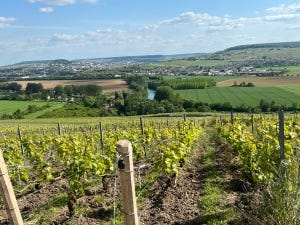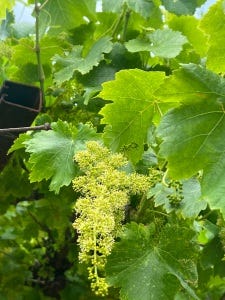Tale of Two (Classical Method) Sparkling Wine Regions: Champagne and Franciacorta.
This spring I was able to take my studies for the WSET diploma course in Sparkling wines on the road – to two areas making high quality sparkling Wine. Champagne, the historic home of classical method sparkling wine, and Franciacorta in Italy’s Lombardy region, a smaller area and a more recent entrant.
The trip offered the chance to compare the regions to the other wine-growing areas we’d recently seen (in southern Italy) and really try to crack some of what makes Champagne and classical method Sparkling wine unique. And with little Franciacorta exported from Italy (only 10%), its really ideal to visit to explore and understand this new sparkling wine.
Champagne: Trying to Get beyond the Brands
This wasn’t my first trip to Champagne, that came when I was an intern at US Embassy London and probably was my first solo wine travel, far far too many years ago, but it was the first since I’d started to properly study wine. Now more than on prior trips, I focused on tasting a bunch of champagnes rather than visiting a lot of vineyards, negotiants or Champagne houses. We enjoyed especially some great Blanc des Blancs (Chardonnay) with some good local food, and some other blends. Some as usual ended up tasting a little too sweet for my taste, but its a good reminded to taste around and see what you like.
Visiting the historic Caves in Reims under the quarries (crayeres) is always inspiring, as is visiting the Avenue du Champagne in Epernay (if only to be reminded of the sheer number of producers), but our goal was to get out and see the grapes. One thing that stands out in Champagne, is the sheer dominance of the wine crop versus other agriculture – in some cases this leads to quite high density of grape production, albeit on largely small plots of land. Compared to Southern Italy, where land is a bit more mixed use, there are vineyards in all directions and there is very little unused land. Higher quality areas have chalkier soil, may be towards top of the hills to improve drainage, benefit from winds off the hills that keep things warmer in winter and get better sun.
Champagne is notable for a large range of quality and production. As with Burgundy, much of the production is by smaller growers who sell grapes to the big houses, who are in effect negotiants (merchants). They vinify, age and store the wine, incurring the key capital cost involved with traditional method sparkling wines. Even quick-to-market champagne requires two fermentations, and aging in bottle as well as extensive labor and machinery for the secondary fermentation and management of what is a highly pressured product. Some producers club together in cooperatives either to sell the grapes together and hope to get a better deal or to collectively make Champagne. One we visited – a premier cru village – Mailly (pinot Noir dominant), had not only put more money into wine production, but also a large tasting room for associated brand management and tourism.
The high capital costs have long made Champagne an area where brands are important- with the wine houses being more important than some of the traditional hyperlocal geographic markers of terroir that dominate in other French or indeed European wine regions. The importance of blending grapes from around the region and existing production mean that Champagne is a relatively large region, stretching from Montagne de Reims in the North to the Cote de Bar South of Troyes with different growing conditions, soils etc throughout the regions. This can lead to balanced wine, but also suggests that the particular geographic area is often less defined. The Brand value also reflects the export orientation of wine which goes back hundreds of years. Brits of the 17th and 18th Centuries were particularly keen on bubbles and better at making strong glass that could support the pressure than their French counterparts, meaning they were early buyers and bottlers. Even now, Champagne is a region of France with the highest export share of wine. The brands, house style and distinctive nature have helped with that.
Champagne is a costly product which involves a lot of work and aging and where many of the flavors are introduced via the wine-making process rather than via the wine-growing process. Its initial creation many centuries ago sought to make the best out of barely ripened grapes by adding sugar and doing a secondary fermentation to add more alcohol, capturing the bubbles along the way. Its still a cool region, where grapes are often picked a little under-ripe, though a small number of producers are increasingly harvesting riper grapes, allowing more fruit flavors to mingle with the autolytic notes from the time on the lees.
Franciacorta: A New Entrant
Franciacorta, in the province of Brescia, about an hour east of Milan, is one of several areas that adopt many of the wine-making techniques of champagne – dual fermentation and long fermentation on the lees, but differences stem from climate and terroir. This means that there are typically strong autolytic flavors of brioche and toast from the time on the lees, and often a creamier mouth-feel from that same time of aging. Indeed if anything Franciacorta mandates longer aging for their basic product than Champagne does.
But there are important differences – the area between Lake Iseo and Monte Orfano is in Northern Italy, but it’s much further south than northern France. Often, the fruit flavors are riper, they are often picked earlier, and Italians tend to shun Pinot Meunier in favor of the other traditional grapes Pinot Noir (or Nero) and Chardonnay, also allowing in Pinot Blanc (Bianco) and the local Erbamat grape. Erbamat, an indigenous varietal can be used up to 10%, tends to be higher acid and is aimed at increasing the distinctiveness of Franciacorta. It also is aimed at reviving an indigenous variety rather than just or primarily relying on international varieties.
With a smaller geographic area, and one that is more mixed use, including industry, other agriculture, and being a later entrant (first such wines were produced in 1961 vs the 18th century for the big champagne houses like Ruinart, Moët etc and DOCG status came only in 1995), the producers in Franciacorta all plumped for higher quality production. This includes with mandatory longer aging time than many regions including a minimum of 18 months on the lees for Brut Non-Vintage, 24 moths for Rose or Saten (a unique wine of the regions with softer bubbles), 30 for Millesimato and 60 for Vintage. This compares to about 15 months minimum for NV Champagne and three years for vintage, though many producers in Champagne also age for longer. Approved land for DOCG status is restricted, with some producers noting that they would be required to declassify some vineyard areas if they wanted to plant others. Such policies, also in other regions, do tend to benefit the existing producing incumbents, but also have net result of quality increase to justify the cost.
Despite the smaller geographical area, there are still considerable variations in the region. The area near Monte Orfano is warmer and grapes harvest earlier – often beginning in early August, and likely earlier in some years due to global warming. In fact, the grapes we saw there were more advanced in flowering than even those many hundreds of kilometres south in Puglia (which has been facing unseasonable rains this year). Other regions of Franciacorta, closer to the lake and a little more north, tend to harvest a bit later.
This more southerly area of Franciacorta houses some of the producers of the local red wines some labelled under Curtefranca DOC label, which allows for both still white (Pinot Bianco, Chardonnay) or red (Cabernet Franc, Cabernet Sauvignon, Merlot, with some potential additions of Piedmontese Nebbiolo or Barbera). More southerly champagne regions also bottle some reds and still roses, especially in regions closer to Burgundy, which are thus warmer. But like Champagne, its the sparkling wine the region is most known for.
As in other up-and-coming Italian wine regions, new wineries are being added regularly even if the terrain is not large. Some of these new entrants previously sold grapes to larger players , but decided to take on the risks more directly. Others are those from other regions seeking a foothold in Franciacorta. We found some very good value Franciacorta including both Zero dosage extra brut and brut wines, which were refreshing but yet still distinctive in flavors. Its definitely an area to watch – and an easy day trip from Milan, just as Champagne still is from Paris, even if both could benefit from a longer stay. In Italy, a stop in Brescia or Bergamo, jointly Italian capitals of Culture this year could round out a visit.
Some good Readings
I read a few interesting books before and during my journeys
Bursting Bubbles: A Secret History of Champagne and the Rise of the Great Growers Robert Walters – perhaps a little too focused on debunking Champagne myths, but a great description of many small producers who are focused on making sparkling wine that speaks to the place, not just a house style.
Uncorked: the Science of Champagne (revised 2013) Gérard Liger-Belair a short tome full of interesting science on bubbles and high quality photos thereof. For those the intersection of science geeks and wine lovers.
There are also plenty of good books on individual wine houses and the development of brand including ones on Veuve Cliquot, who was responsible for many production innovations – and of course one of a few widows who took over and grew champagne houses in the 18th Centuries.








